List of early settlers of Rhode Island
This is a collection of lists of early settlers (before 1700) in what became the Colony of Rhode Island and Providence Plantations and later the state of Rhode Island. Most of the lists are of the earliest settlers or inhabitants of a particular town or area.
Aboriginal tribes and leaders

The following aboriginal people lived in what became the state of Rhode Island.[1]
Wampanoag people lived throughout Plymouth Colony and around Mount Hope Bay (later Bristol, Rhode Island)
- Massasoit, tribal leader; met the Pilgrims at Plymouth
- Wamsutta, son of Massasoit, became tribal leader upon father's death, but died shortly thereafter
- Metacomet, son of Massasoit, succeeded his brother as tribal leader; given English name of King Philip, instigated King Philip's War
Narragansett people lived throughout the Rhode Island colony
- Canonicus, chief sachem, deeded to Roger Williams land that became Providence Plantations
- Miantonomo, nephew of Canonicus, sold the land that became Warwick to Samuel Gorton and others
- Canonchet, son of Miantonomo, led Narragansets during Great Swamp Fight; accepted his own death at end of King Philip's War
- Pumham, lesser sachem of what became Kent County, Rhode Island
- Soconoco, lesser sachem of the same area as Pumham
Niantic people lived around the Pawcatuck River, in the western part of Rhode Island
- Ninigret, kept the Niantic people from participating in King Philip's War
Nipmuc people wandered within the colony of Rhode Island, mostly from the north
First European settler
- William Blackstone, settled along the Blackstone River, now in Cumberland, Rhode Island, 1634-5 (then part of the Plymouth Colony)[2]
First settlers of Providence
Those who came to Seekonk with Roger Williams early 1636
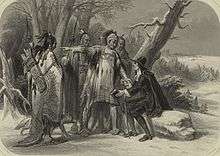
Roger Williams was banished from the Massachusetts Bay Colony in October 1635 but was allowed to remain at his home in Salem until the end of winter, provided that he did not preach. However, his followers visited him at his home in sizable numbers, and the authorities deemed this as preaching. He was to be apprehended and put on a ship for England in January 1636. He was, however, tipped off by magistrate John Winthrop and slipped away from Salem near the middle of January, in the dead of winter, to find shelter with the Wampanoags. He bought a parcel of land in Seekonk from Wampanoag sachem Massasoit which was then at the western edge of the Plymouth Colony (now Rehoboth, Massachusetts). In a 1677 statement, Williams mentioned the four who were with him at Seekonk. The five members of the group were:[3][4][5]
- Roger Williams
- William Harris
- John Smith (miller)
- Francis Wickes
- Thomas Angell
Those who first settled Providence

In the spring of 1636, Williams and his company planted crops at Seekonk but were informed in a gentle letter from Governor Edward Winslow of Plymouth that they were within Plymouth's jurisdiction, and this fact would cause difficulties with the Massachusetts authorities. Without urgency, Winslow suggested that Williams and his group move across the Seekonk River into the territory of the Narragansetts, where no colony had any claim. By this time, it is likely that the family members of the original settlers had joined the group. Two other families also joined the settlement. Joshua Verin wrote a statement in 1650 mentioning "we six which came first to Providence", suggesting that he was the next to join the original five.[6] Also, Benedict Arnold later wrote, "Memm. We came to Providence to Dwell the 20th of April, 1636"; Providence had not yet been established, so he certainly was referring to Seekonk, where the Arnolds came from Hingham to join the other settlers.[6][7] It is likely, therefore, that sometime about June 1636 the following 25 people crossed the river from Seekonk, in the Plymouth Colony, to a location on the Moshassuck River in Narragansett territory which Williams soon named Providence Plantation:[8]
- Roger Williams with wife Mary and daughters Mary and Freeborn
- William Harris with wife Susannah and son Andrew
- John Smith (miller) with wife Alice and children John Jr. and Elizabeth
- Francis Wickes, a minor
- Thomas Angell, a minor
- Joshua Verin with wife Jane
- William Arnold with wife Christian, daughter Joanne, and son Stephen
- Benedict Arnold, still a minor, son of William Arnold
- William Carpenter with wife Elizabeth (the daughter of William Arnold)
- William Mann with wife Frances Hopkins (the niece of William Arnold)[9]
- Thomas Hopkins, still a minor, nephew of William Arnold (and ancestor of Governor Stephen Hopkins)
Original proprietors of Providence
Those named in a deed from Roger Williams, dated about 8 October 1638[10]
- Roger Williams
- Stukeley Westcott (left Salem about March 1638)[11]
- William Arnold
- Thomas James (was minister at Charlestown; Providence by June 1637; left for New Haven in 1639)[12]
- Robert Cole (was earlier at Ipswich and Salem)[13]
- John Greene (had departed Boston by March 1636)[14]
- John Throckmorton (was at Salem earlier)[15]
- William Harris
- William Carpenter
- Thomas Olney (left Salem about March 1638)[16]
- Francis Weston (left Salem about March 1638)[17]
- Richard Waterman (left Salem about March 1638)[18]
- Ezekiel Holyman (left Salem about March 1638)[19]
Providence civil compact, 1637
Several young men were admitted as inhabitants to Providence before the settlement was a year old, but they were discontent with their position and wanted to be able to vote and otherwise have equality with the older settlers. The following resolution was adopted in a town meeting on 20 August 1637, and is sometimes called the "civil compact." The 1637 date was on the original town records, but when they were transcribed in 1800, the page containing that date was missing. The text of the resolution is as follows:
We, whose names are hereunder, desirous to inhabit in the town of Providence, do promise to subject ourselves in active or passive obedience to all such orders or agreements as shall be made for public good of our body, in an orderly way, by the major assent of the present inhabitants, master of families, incorporated together into a town fellowship, and others whom they shall admit unto them only in civil things.[20]
- Richard Scott
- William Reynolds X his mark
- John Field X his mark
- Chad Browne
- John Warner
- George Richard
- Edward Cope
- Thomas Angell X his mark (now an adult)
- Thomas Harris
- Francis Wickes X his mark (now an adult)
- Benedict Arnold (now an adult)
- Joshua Winsor
- William Wickenden
Pawtuxet settlers

Those settlers who left Providence to settle on the north side of the Pawtuxet River about 1638, putting themselves under the jurisdiction of Massachusetts from 1642 to 1658[21][22][23][24]
- William Arnold
- Benedict Arnold, moved to Newport in 1651
- William Carpenter
- Thomas Hopkins, did not stay long
- William Mann, did not stay long
- Robert Cole
- William Harris, did not stay long
- Zachariah Rhodes (married Joanna, daughter of William Arnold), did not stay long
- William Field, did not stay long
- Stukeley Westcott, moved to Warwick about 1643
Signers of Providence agreement for a government, 1640

Those 39 Providence settlers who signed an agreement to form a government on 27 July 1640:[25]
- Chad Brown
- Robert Cole
- William Harris
- John Throckmorton
- Stukely Westcott
- Benedict Arnold
- William Carpenter
- Richard Scott
- Thomas Harris
- Francis Wickes X his mark
- Thomas Angell X his mark
- Adam Goodwin X his mark
- William Burrows X his mark
- Roger Williams
- Robert West
- Joshua Winsor
- Robert Williams
- Matthew Waller
- Gregory Dexter
- John Lippitt X his mark
- John Warner
- John Field
- William Arnold
- William Field
- Edward Cope
- Edward Manton X his mark
- William Man
- Nicholas Power
- William Reynolds X his mark
- Thomas Olney
- Richard Waterman
- William Wickenden
- Edward Hart
- Hugh Bewit
- Thomas Hopkins X his mark
- Joan Tiler (widow)
- Jane Sears X her mark (widow)
- Christopher Unthank
- William Hawkins X his mark
Settlers of Cocumscussoc (Wickford) area
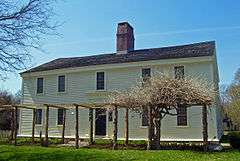
Those early settlers who had trading posts in the area of Wickford in what was then the "Narragansett country" and later a part of North Kingstown, Rhode Island:[26][27]
- Richard Smith, built a trading post established about 1637, where his house Smith's Castle still stands, rebuilt by Richard, Jr. after King Philip's War.
- Roger Williams, built his trading post about a mile north from Smith's post along the Pequot Path (or Post Road) and occupied it from about 1644 to 1651 and then sold it to Smith to get funds for his proposed errand to England.
- Mr. Wilcox (possibly Edward or John), built his trading post in the early 1640s in the same general area.
Founders of Portsmouth
Supporters of Anne Hutchinson who signed the Portsmouth Compact, dated 7 March 1638[28]
- William Coddington
- John Clarke
- William Hutchinson, husband of Anne Hutchinson
- John Coggeshall
- William Aspinwall
- Samuel Wilbore
- John Porter
- John Sanford
- Edward Hutchinson, Jr., oldest son of William and Anne Hutchinson
- Thomas Savage
- William Dyer, husband of Mary Dyer
- William Freeborn
- Philip Shearman
- John Walker
- Richard Carder
- William Baulston
- Edward Hutchinson, Sr., brother of William Hutchinson
- Henry Bull (signed with a mark)
- Randall Holden
- Thomas Clarke
- John Johnson
- William Hall
- John Brightman
The last four names on the list were crossed out, but these men nevertheless came to Portsmouth or Newport.
Inhabitants of Aquidneck Island (1638)
The following individuals were among the earliest settlers of Aquidneck Island in the Narragansett Bay, which was later named Rhode Island (from which the entire colony was given its name). The first group of 58 names appears to be settlers of Pocasset (later Portsmouth), while the second group of 42 appears to be settlers of Newport. These two lists come from Bartlett's Records of the Colony of Rhode Island..., and apparently the lists were compiled and incorporated into the town records of Newport on 25 November 1639. The actual arrival dates of the individuals likely span over several months during 1638; a few individuals have legible dates next to their names, while several others have illegible dates.[29]
"A Catalogue of such [persons] who, by the Generall consent of the Company were admitted to be Inhabytants of the Island now called Aqueedneck, having submitted themselves to the Government that is or shall be established, according to the word of God therein" [1638]
|
|
|
"Inhabitants admitted at the Town of Nieu-port since the 20th of the 3:1638" (since 20 May 1638)
|
|
|
Residents of Portsmouth after split with Newport
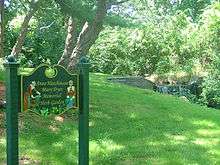
Those Portsmouth settlers who remained after the group left to found Newport, and who signed an agreement for a government on 30 April 1639:[30]
- William Hutchinson
- Samuel Gorton
- Samuel Hutchinson, did not stay long if actually here
- John Wickes
- Richard Magson
- Thomas Spicer
- John Roome
- John Geoffe (?)
- Thomas Beddar
- Erasmus Bullock
- Samson Shotten
- Ralphe Earle
- Robert Potter
- Nathaniel Potter
- George Potter
- William Havens
- George Shaw
- George Lawton
- Anthony Paine
- Job Hawkins
- Richard Awarde
- John Moore
- Nicholas Browne
- William Richardson
- John Tripp
- Thomas Layton
- Robert Stanton
- John Briggs
- James Davis
- William Aspinwall (did not sign agreement, but did remain here)
Founders of Newport
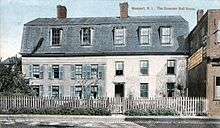
Those who signed an agreement for a new government, 28 April 1639[31]
- William Coddington
- Nicholas Easton
- John Coggeshall
- William Brenton
- John Clarke
- Jeremy Clarke (his wife was Frances (Latham) Clarke)
- Thomas Hazard
- Henry Bull
- William Dyer
Founders of Warwick

Those who purchased the land from the Indians, January 1643[32]
- Randall Holden
- John Greene
- John Wickes
- Francis Weston
- Samuel Gorton
- Richard Waterman
- John Warner
- Richard Carder
- Samson Shotten
- Robert Potter
- William Wodell
- Nicholas Power
Pettaquamscutt purchasers
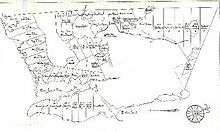
Those who purchased the Pettaquamscutt lands (later South Kingstown) from the Indian sachems, 1657[33]
Original purchasers:
- John Porter
- Samuel Wilbore
- Thomas Mumford
- Samuel Wilson
- John Hull (Boston goldsmith and minter)
Later purchasers:[34]
Early inhabitants of New Shoreham (Block Island)
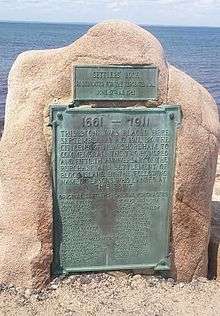
The original purchasers of Block Island in April 1661, whose names appear on a plaque at the north end of the island, were: Thomas Terry, John Clarke, William Jud, Samuel Dearing, Simon Ray, William Tosh, Tormut Rose, William Barker, Daniel Cumball, William Cohoone, Duncan Mack Williamson, John Rathbun, Edward Vorce, Jun., Trustrum Dodge, Sen., Nicholas White, William Billings, and John Ackurs (Acres). Those early settlers whose names appear on the plaque were:[35]
- Richard Billingum
- Samuel Dearing
- Nathaniel Winslow
- Tormut Rose
- Edward Vorce
- John Rathbun
- Thomas Faxson
- Richard Allis
- Phillip Warton
- John Glover
- Thomas Terry
- James Sands
- Hugh Williams
- John Alcock
- Peter George
- Simon Ray
- Trustrum Dodge was also an early settler, though his name only appears on the plaque as an original purchaser
Those named in the Royal Charter of 1663

The early Rhode Island inhabitants named in the Rhode Island Royal Charter, dated 8 July 1663, and signed with the royal seal by King Charles II; this charter was the basis for Rhode Island's government for nearly two centuries:[36]
- Author: John Clarke
- Governor: Benedict Arnold
- Deputy Governor: William Brenton
Assistants:
- William Baulston
- John Porter
- Roger Williams
- Thomas Olney
- John Smith
- John Greene
- John Coggeshall
- James Barker
- William Field
- Joseph Clarke
Others named in the document:
- William Codington
- Nicholas Easton
- Samuel Gorton
- John Wickes
- Gregory Dexter
- Randall Holden
- John Roome
- Samuel Wildbore
- Richard Tew
- Thomas Harris
- William Dyre
- ________ Rainsborrow (given name omitted)
- ________ Williams (this is undoubtedly Robert Williams, brother of Roger Williams)
- John Nickson
Early inhabitants of Westerly
Westerly, at first called Misquamicut, was purchased on 27 August 1661 by the following Newport men: William Vaughan, John Coggeshall, Jr., John Crandall, Hugh Mosher, James Barker, Caleb Carr, James Rogers, Joseph Torry, and John Cranston. Of these men, only John Crandall appears to have settled in Westerly. Following is a list of 24 Westerly inhabitants appearing in the town records of 18 May 1669:[37]
|
|
Colonial leaders during King Philip's War

During the devastating events of King Philip's War (1675-1678), the Rhode Island General Assembly sought the counsel of 16 prominent citizens of the colony with the following resolution, "Voted that in these troublesome times and straites in this Collony, this Assembly desiringe to have the advice and concurrance of the most juditious inhabitants, if it may be had for the good of the whole, doe desire at their next sittinge the Company and Councill of [the following]..."[38]
- Mr. Benedict Arnold
- Mr. John Clarke
- Mr. James Barker
- Mr. Obadiah Holmes
- Mr. William Vaughan
- Mr. William Hiscocks
- Mr. Christopher Holder
- 'Mr. Phillip Shearman
- Capt'n John Albro
- Mr. William Wodell
- Mr. George Lawton
- Mr. Robert Hodgson
- Mr. William Carpenter
- Mr. Gregory Dexter
- Capt. Randall Holden
- Capt. John Greene
Original proprietors of East Greenwich
At a meeting of the General Assembly in Newport in May 1677, the following 48 individuals were granted 100-acre tracts in East Greenwich "for the services rendered during King Philip's War."[39]
|
|
Settlers of Frenchtown
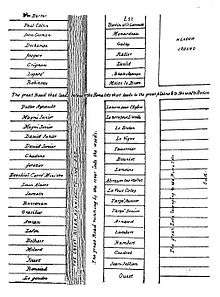
The following individuals were French Huguenots who settled in what is now East Greenwich in 1687. On 12 October 1686 an agreement was signed between Richard Wharton, Elisha Hutchinson (son of Edward Hutchinson), and John Saffin, representing the Proprietors of the Narragansett Country, and Ezechiel Carre', Peter Le Breton and others representing the French immigrants. The following individuals signed the follow-on agreement, usually giving only their surname, and these same names are found on a plat map of the settlement. Also on the map are two additional lots: "La terre pour L'Eglise" (land for the church), and "La terr pour L'ecolle" (land for the school). Following some severe civil clashes with the English settlers, almost all of these people left Rhode Island to settle in Massachusetts and New York. Two families remained on their original land, however: LeMoine (later anglicized to Money, and then Mawney), and Targe' (which became Tourgee), and a third family, the Ayraults, moved to Newport.[40]
- William Barbret
- Paul Collin
- Jean Germon
- Dechamps
- Fougere
- Grignon
- Legare'
- Robineau
- Petter Ayrault
- Magni, Junior
- Magni, Senior
|
|
Other prominent early settlers (pre-1700)
- Jireh Bull, early settler of Pettaquamscutt (South Kingstown)
- Benjamin Church (ranger), prominent colonial military leader
- Thomas Cornell (settler)
- Joseph Jenckes, early settler of Pauwtucket, Warwick and Providence
- Stephen Northup, built house that remains as one of oldest in the state
- John Steere, early settler of Providence and Smithfield, Rhode Island
- John Sweet
- Pardon Tillinghast, early pastor of the First Baptist Church in America
- John Whipple, early settler of Providence
See also
References
- ↑ Arnold, Samuel Greene (1859). History of the State of Rhode Island and Providence Plantations. Vol.1. New York: D. Appleton & Company. pp. 73–4.
- ↑ Arnold, 98-9
- ↑ Arnold, 97
- ↑ Bicknell, 1:158
- ↑ Chapin, Howard M. (1916). Documentary History of Rhode Island. Providence: Preston and Rounds Company. pp. 8–16.
- 1 2 Chapin, 11
- ↑ Bicknell, Thomas Williams (1920). The History of the State of Rhode Island and Providence Plantations. Vol. 1. New York: The American Historical Society. pp. 143, 158.
- ↑ Chapin, 17
- ↑ Moriarty, G. Andrews (April 1944). "Additions and Corrections to Austin's Genealogical Dictionary of Rhode Island". The American Genealogist. 20: 227.
- ↑ Arnold, 100
- ↑ Austin, John Osborne (1887). Genealogical Dictionary of Rhode Island. Albany, New York: J. Munsell's Sons. p. 416. ISBN 978-0-8063-0006-1.
- ↑ Anderson, Robert Charles (1995). The Great Migration Begins, Immigrants to New England 1620–1633. Boston: New England Historic Genealogical Society. pp. 1072–1076. ISBN 0-88082-044-6.
- ↑ Austin, 50
- ↑ Anderson, Robert Charles; Sanborn, George F. Jr.; Sanborn, Melinde L. (2003). The Great Migration, Immigrants to New England 1634–1635. Vol. III G-H. Boston: New England Historic Genealogical Society. p. 142. ISBN 0-88082-158-2.
- ↑ Austin, 200
- ↑ Anderson, Robert Charles (2007). The Great Migration, Immigrants to New England 1634–1635. Vol. V M-P. Boston: New England Historic Genealogical Society. p. 302. ISBN 978-0-88082-211-4.
- ↑ Anderson (1995), p. 1967
- ↑ Anderson (1995), p. 1943
- ↑ Austin, 102
- ↑ Field, Edward (1902). State of Rhode Island and Providence Plantations at the End of the Century: A History. 1. Boston: Mason Publishing Company. p. 33.
- ↑ Gorton, Adelos (1907). The Life and Times of Samuel Gorton. George S. Ferguson Co. p. 39.
- ↑ Arnold, 102
- ↑ Bicknell, 1:143
- ↑ Moriarty, 20:227
- ↑ Staples, William R. (1843). Annals of the Town of Providence, from its First Settlement to the Organization of the City Government in June 1832. Providence: Printed by Knowles and Vose. pp. 40–43.
- ↑ Arnold, 195
- ↑ Bicknell, Thomas Williams (1920). The History of the State of Rhode Island and Providence Plantations. Vol 2. New York: The American Historical Society. pp. 469–70.
- ↑ "The Portsmouth Compact". Retrieved 2011-08-15.
- ↑ Bartlett, John Russell (1856). Records of the Colony of Rhode Island and Providence Plantations in new England. 1. Providence: A. Crawford Greene and Brother. pp. 90–93.
- ↑ Arnold, 133
- ↑ Arnold, 132
- ↑ Arnold, 176
- ↑ "Kingston Congregational Church Collection". Retrieved 2011-08-15.
- ↑ "History of Washington and Kent Counties, Rhode Island". Retrieved 2011-08-15.
- ↑
- "Block Island settlers". Retrieved 2 June 2012.
- ↑ "Charter of Rhode Island and Providence Plantations". Retrieved 2011-12-09.
- ↑ Denison, Frederic (1878). Westerly (Rhode Island) and its Witnesses, for Two Hundred and Fifty Years, 1626-1876. Providence: J.A. & R.A. Reid. pp. 47, 52.
- ↑
- Holmes, James T. (1915). The American Family of Rev. Obadiah Holmes. Columbus, Ohio: private. p. 41.
- ↑ Greene, Daniel H. (1877). History of the Town of East Greenwich and Adjacent Territory from 1677 to 1877. Providence: J.A. & R. A. Reid. pp. 9–10.
- ↑ Potter, Elisha R. (1879). Memoir Concerning the French Settlements and French Settlers in the Colony of Rhode Island. Providence: Sidney S. Rider. pp. 10–15.
External links
- 1638 inhabitants of Aquidneck Island
- Early Rhode Island maps
- Original purchasers and settlers of Block Island

